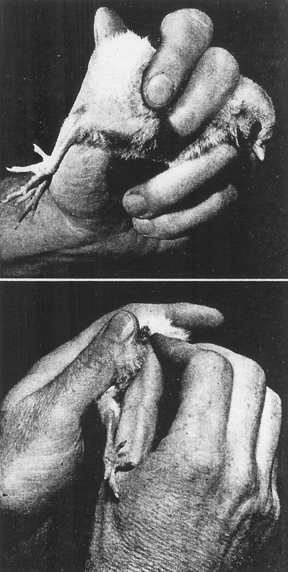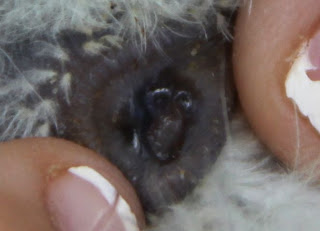By Leigh ~
If
you’re here because you did a search for “Sexy Chicks,” you’ll likely be very disappointed
with the following information. If, on the other hand, you are interested in poultry, sexing chicks and have questions like:
“Can
I sex my own chicks?”
“I
ordered all pullets but the hatchery sent me a cockerel too. Why?”
“Do
I have to wait until they crow or lay an egg to find out which of my chicks are
males and females?”
“Do male chicks and female chicks look different right from hatch in some breeds?”
…then
you’re in the right place!
So
– you want to know how to tell the gender of chicks. (And don’t we all?)
Unfortunately for most breeds of chicken, there is not a simple answer. Yes –
you can sex your own chicks if you
know what to look for… and if you happen to have really good eye sight…
Vent Sexing
The
beginnings of vent sexing – the art of looking in the vent of a day-old chick
to spot a male phallus or the lack thereof - began in 1925 when three
researchers at Tokyo Imperial University developed a workable method of identifying
chick gender with high accuracy. It had long been thought that the sex organ of
cockerels was not something visible, but Drs. Juro
Hashimoto, Dr. Kiyoshi Masui and Isamu Ono proved that theory to be incorrect…
for the most part. (Yeah – you knew
it had to be a group of men out to
disprove the theory that size doesn’t matter… but I digress…)
Cockerels do in fact have a (barely) visible phallus. You have
to be quick, gentle and have really, really good eyes to see it. Unfortunately
one can’t simply ask a chick to lie back on an exam table, relax and put their
feet into stirrups for a quick look at their nether regions, so an alternative
had to be developed. The following photograph from an educational bulletin, created by Thomas H. Canfield sometime in the 1950's,
illustrates one way to hold chicks while vent sexing.
Wikipedia
(Chick Sexing) offers the following for the proper vent sexing of chicks:
- “Before
examining the vent, discharge the chicken´s excretions by lightly pressing on
both sides of the abdomen in a downward motion.
- Place
the chicken on its back in the palm of your hand with the head towards you, put
your thumb and first two fingers around its thighs to hold it.
- Tip
your hand so that the chicken´s breast is towards you, vent uppermost.
- Place
your middle fingers over the chicken´s breast to support the chicken leaving
your thumb free. (If you have large hands, place the chicken´s head between
your little finger and ring finger for additional support.)
- Place
the thumb of your other hand on the lower portion of the vent (anus).
- Using
the index finger start from the top of the vent moving down, back and around,
rolling the vent in a sideways action.
- At
the same time a similar action with the free thumb, starting from the top and
rolling down and back.
- With
the thumb and forefinger placed either side of the vent apply gentle pressure
and a rolling action to evert the vent and expose the male eminence or lack of
it (sexed as female). After a little practice this can be accomplished without
injury or significant discomfort to the chicken.”
OK – so I’m not one to post an article like this unless I have
at least tried it myself, and I can tell you… that first step is kind of important. On one
hand I’d say “I couldn’t see $#!+,” but it wouldn’t be accurate. Truth be told,
in that first try (sans step 1) the only thing I could see was poop.
Once the poop was taken care of, and after trying to get the
hold just right on a squirming chick who was very vocal about questioning my
intentions, I still couldn’t tell what the heck I was looking at. Yes – I was
doing this outside by the coop. I can only wonder what the people who drove
past right at that moment were thinking about this woman holding a chicken’s butt inches from her face… (Oh the
things one sees in the country…)
In theory the vent is supposed to look something like this:
Illustrator,
Jean E. Hirsch (Canfield, 1950)
But all I could see was this:
And this:
And this:
Yeah – I still have no idea what genders my newest
babies are… and I think their mother is considering filing charges against me.
According to the pros, holding the chick and opening up the vent
are barely even part of the art of sexing. It’s like a painter learning to hold
a brush. Learning to identify what you are looking at is the real Mona Lisa of
the chick-sexing world… and in comparison my own attempts come off rather like feeble
stick figures… of unknown gender.
The following illustrations by Jean E. Hirsch, found in a Thomas H. Canfield publication from 1950, shows
a few of the possible variations in chick genitalia... because heaven forbid it be as simple innie
vs. outie.
Left: Cockerel - Right: Pullet
Illustrator,
Jean E. Hirsch (Canfield, 1950)
After looking over these
illustrations (and keeping in mind that these are quite a bit larger and less
squirmy than the real things), perhaps we all have a better understanding of
why hatcheries make mistakes. In fact US hatcheries have a chick sexing
accuracy rate of about 70% on average. Needless to say, a chick sexing job probably
does not pay too much more than a burger flipping job. (If you are a
professional chick sexer, please leave me a comment if I am incorrect in this
assumption. And yeah – after a dismal attempt to try sexing my own chicks, I totally
bow to you as an artist and think you should be better compensated for your
talent!)
I was lucky to find the following (much better) photos on a thread at Back Yard Chicken site found HERE.
Pop Quiz! Based upon the illustrated examples above, can you identify each chick's gender below?
(The following photos were posted on BYC by al6517)
(The answers can be found at the end of this post.)
If you absolutely, positively have to have pullets…
You can thank Professor Reginald C.
Punnett. For those of you who stayed awake through Genetics 101, you’ll recognize
Professor Punnett’s name from the Punnnett Square. Luckily for us, this
particular brainiac liked chickens and many of his findings on genetic
variations came as a result of his interest in breeding poultry. He was the
first to identify breed crosses that resulted in both Sex Linked chicks and Autosexing Breeds.
The Sex Link
“Sex link” does not mean two
birds stuck together whilst breeding as my husband wondered, but refers to easily sexable chicks that result from a cross of two breeds. Upon hatch, Professor
Punnett discovered that the genders of newly-hatched chicks could be identified
by markings and coloration.
Black Sex Links (also sold under the name of Rock Reds) result from a cross between a
solid colored rooster and a hen with a barred pattern. Most hatcheries use a Rhode
Island Red or New Hampshire rooster and a Barred Plymouth Rock hen. All
resulting chicks will have black down but the cockerels can be easily
identified by a white dot on the head. At maturity the males will have the
Barred Rock pattern with some red intermingled in the feathering while the hens
will be black with some red in the hackles.
Red Sex Links (Also known as Golden Comets, Gold Stars and Cinnamon Queens) are the
result of a variety of crosses.
Golden Comet refers
to a cross between a New Hampshire rooster and a White Plymouth Rock hen.
Cinnamon Queens are a crossing of a New Hampshire rooster and a Silver Laced Wyandotte
hen.
Other crosses that will create Red Sex
Link chicks are a Rhode Island Red rooster over a Delaware hen or a Rhode
Island White hen.
Red Sex Link cockerels will be white
at hatch while pullets will be red or buff at hatch.
The sex-linked trait only shows up in
the first generation of chicks. It is not possible to breed a sex-linked
rooster with a sex-linked hen and get sex-linked chicks. If a person wishes to
create their own sex-linked chicks, they would need to have some of the above combinations.
(I have an extra Heritage Rhode Island Red cockerel who would be happy to “link
up” with your hens… any takers?)
Read more about sex linked breeds at
the University of Kentucky College of Agriculture, Food and Environment link
found HERE.
Auto
Sexing Breeds
The autosexing breeds are another of Punnett’s conceptions.
Autosexing breeds breed true in that pure-bred birds can
be sexed at hatch, generation after generation, based upon markings and coloration. Autosexing breeds are
derived from breeds with barred markings crossed with other specific breeds. If you are serious about
creating a quality flock of autosexing birds, you can refer to THIS
site which lists the crosses that create autosexing breeds. From there, I would
recommend finding the highest quality birds available from each breed (have I
mentioned I have a really nice H/RIR cockerel up for grabs?)… and start your
hatching.
(Photo courtesy of Justine Lewis of Les Farms)
While autosexing breeds are often developed from a cross between
two breeds, one of Punnett’s own creations, the Cream Legbar, results from a
careful mix of Araucana, Brown Leghorn and Gold Legbar. (It should be noted that
the Gold Legbar is derived from a cross between the Brown Leghorn and the
Barred Plymouth Rock.) The final result is a pretty bird that is a prolific layer of blue eggs,
yet all the cockerels (easily identifiable at hatch) mature to be heavy enough to make a decent meal.
You can see photos of the Cream Legbar HERE.
So… who knew you’d be getting a chicken sex-ed and genetics
course all in one post? (You just never know what we’ll do next here on NCK!)
And if you haven’t already joined our forum, don’t be chicken!
Join now! You can ask all kinds of chicken or homesteading type questions out
there and get good, holistic advice and answers from people who won’t suggest the use of chemicals or
antibiotics. Join our forum HERE.
Happy Thursday!
~ Leigh
Sources:
Photo Pop Quiz Answers: Cockerel, Pullet, Pullet, Cockerel.
Leave a comment and tell us how you did on the pop-quiz!
*






































